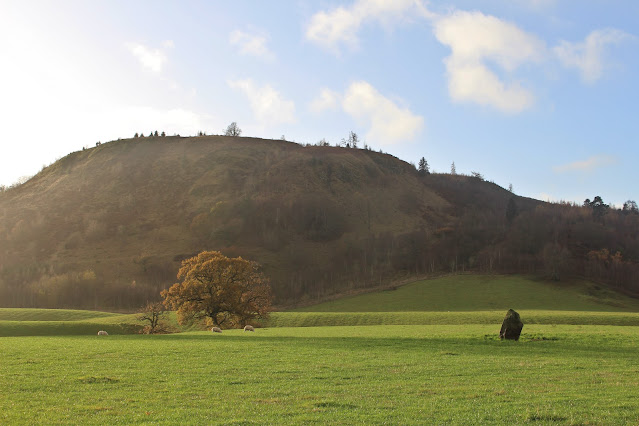The other day, I walked up to Skirley Craig hillfort on the
boundary of the Scottish highlands, to the north of Crieff. Crieff is a small
town in Strathearn, located on a hill overlooking the valley. Just to the north
of the town is the Knock of Crieff, which is Gaelic for the hill of Crieff. The name Crieff is derived from
the Gaelic, Craoibh, which means ‘tree’ or perhaps ‘sacred tree’. To the north of the hill or knock, is
Monzie estate. I walked through the estate on my way to Skirley Craig hillfort,
and came across a stone circle or burial cairn. There was a large stone lying
flat on the ground, which had ‘cup and ring mark’ carvings. The carvings are
thought to date to the Neolithic, around 5,000 years ago. The meaning and purpose
of the carvings is unknown. However, I would like to think that they were
trying to map the heavens. Most of the cup and ring mark carvings in Scotland
are found to the west, with good examples in Kilmartin glen in Argyll. They’re
found in Scotland, Wales, Ireland, northern England, Brittany in France,
Galicia in Spain, and Portugal, along the coast of the Atlantic. There are also
examples elsewhere in the world. This is one of the best examples I’m aware of
in central and north east Scotland. To the east of the stone circle is
Milquhanzie hill, which is also the site of a hillfort.
Once I had walked through Monzie estate, I climbed up
towards the hills. After half an hour or so, I could see Skirley Craig hill.
The hill is a ridge which runs from east to west, with a steep cliff on the
north side. The hillfort is located on the western end of the ridge. There
isn’t a lot of information on the hillfort. It probably dates to the iron age
or later Pictish times. The hillfort is defended to the east by two or three
ramparts, which run towards the western end of the ridge. They may have been
dry stone ramparts or earthen ramparts with wooden palisades. There’s an
entrance in the ramparts to the east. The hillfort has commanding views all
around. It may have been occupied on a permanent basis or it may have been a
place of refuge during times of crisis. It may have also been used on a
seasonal basis, perhaps when the cattle and other animals were driven to higher
ground during the summer.
 |
| The north side of the Knock of Crieff and a standing stone. |
|
 |
The cup and ring marked stone and the stone circle, with Milquhanzie hill in the distance.
|
 |
Skirley Craig hill.
|
 |
Skirley Craig hillfort. The entrance and the ramparts are just visible.
|
 |
The entrance and the ramparts of the hillfort.
|
 |
The north side of the ridge.
|
 |
The view towards Milquhanzie hill (on the left) and the Knock of Crieff (on the right).
|
-----------------------
If you find these articles interesting, I have a number of books on early Scottish history. They're available on the My Books page.







Comments
Post a Comment